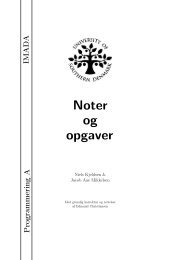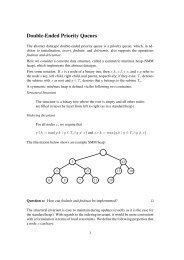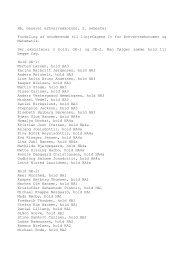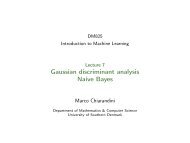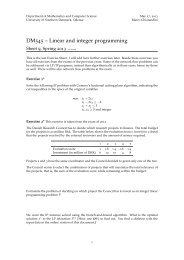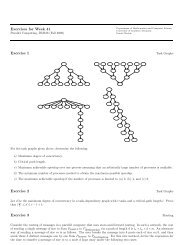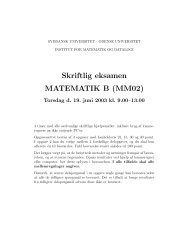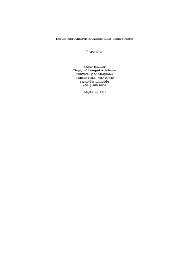Exercises for Week 39 Exercise 1 Exercise 2
Exercises for Week 39 Exercise 1 Exercise 2
Exercises for Week 39 Exercise 1 Exercise 2
Create successful ePaper yourself
Turn your PDF publications into a flip-book with our unique Google optimized e-Paper software.
<strong><strong>Exercise</strong>s</strong> <strong>for</strong> <strong>Week</strong> <strong>39</strong><br />
Parallel Computing, DM818 (Fall 2009)<br />
Department of Mathematics and Computer Science<br />
University of Southern Denmark<br />
Daniel Merkle<br />
<strong>Exercise</strong> 1<br />
Static Network Topology<br />
We discussed the static network topology d-dimensional hypercube. A disadvantage of a hypercube-based<br />
architecture is that the degree grows with growing values <strong>for</strong> d. A modification of the hypercube is the<br />
so called cube-connected cycle graph (CCC-graph), that doesn’t have that property.<br />
Cube-connected cycle<br />
graph <strong>for</strong> d = 3<br />
For a CCC-graph each node of a hypercube is replaced by a ring of d nodes. The set of nodes is defined<br />
by V CCC = V H × {0, . . . , d − 1}. In a CCC-graph there is a edge between nodes (v, i) and (v ′ , i ′ ) if<br />
• i = i ′ and v and v ′ differ only in the i−th bit, or<br />
• |i − i ′ | = 1 and v = v ′ , or<br />
• i − i ′ = d and v = v ′ .<br />
a) Determine the number of shortest paths between two nodes v 1 and v 2 in a standard hypercube.<br />
Hint: use the binary node labeling.<br />
b) Determine the number of nodes and edges in a CCC-graph and of a hypercube with dimensionality d.<br />
c) Determine the diameter of a CCC-graph <strong>for</strong> d = 3.<br />
d) Determine the diameter of a CCC-graph <strong>for</strong> d ≥ 4. Explain how you derived the <strong>for</strong>mula and give<br />
an example <strong>for</strong> the case of d = 4. (A proof would be very complicated and is not necessary).<br />
e) ∗ (to be discussed in a later tutorial section). Explain an optimal routing algorithm in a CCC-graph.<br />
(The solution <strong>for</strong> this question is quite complicated, this part will not be presented in detail.)<br />
<strong>Exercise</strong> 2<br />
Hypercube<br />
A cycle in a graph is defined as a path originating and terminating at the same node. The length of a<br />
cycle is the number of edges in the cycle. Show that there are no odd-length cycles in a d-dimensional<br />
hypercube.
<strong>Exercise</strong> 3<br />
Hypercube<br />
The diameter of a network is the maximum distance between any two processing nodes in the network.<br />
The bisection width of a network is defined as the minimum number of communication links that must<br />
be removed to partition the network into two equal halves. The arc connectivity of a network is the<br />
minimum number of edges that must fail (be removed from the network) to fragment the network into<br />
two unreachable parts. The cost of a network can be defined in many ways, <strong>for</strong> this exercise let the cost<br />
be the number of communication links between nodes.<br />
Discuss all entries of Table 2.1 in the course book.<br />
<strong>Exercise</strong> 4<br />
Mesh of Trees<br />
A mesh of trees is a network that imposes a tree interconnection on a grid of processing nodes. A √ p× √ p<br />
mesh of trees is constructed as follows. Starting with a √ p × √ p grid, a complete binary tree is imposed<br />
on each row of the grid. Then a complete binary tree is imposed on each column of the grid. Figure 1<br />
illustrates the construction of a 4 × 4 mesh of trees. Assume that the nodes at intermediate levels are<br />
switching nodes. Determine the bisection width, diameter, and total number of switching nodes in a<br />
mesh of trees.<br />
Figure 1: Mesh of Trees





